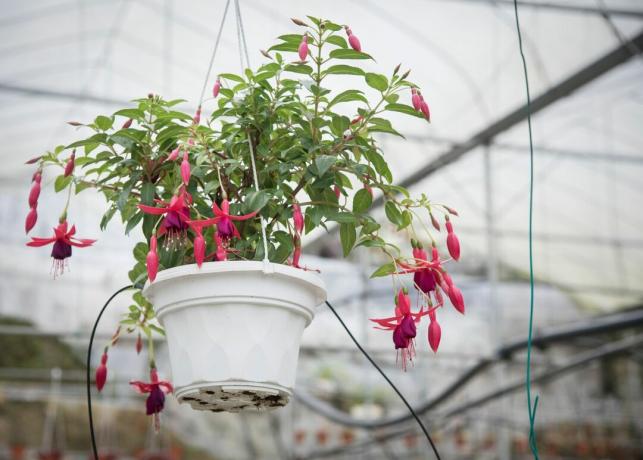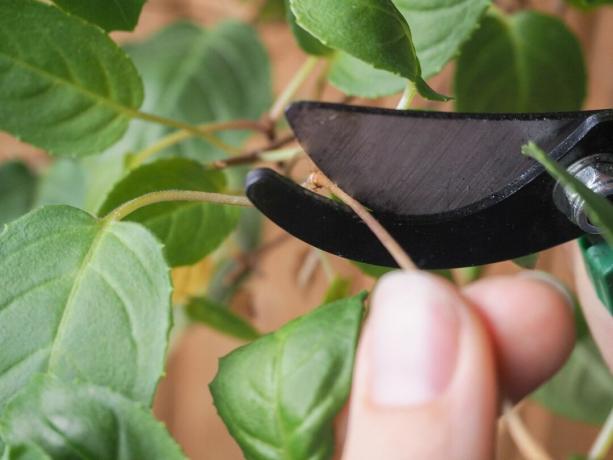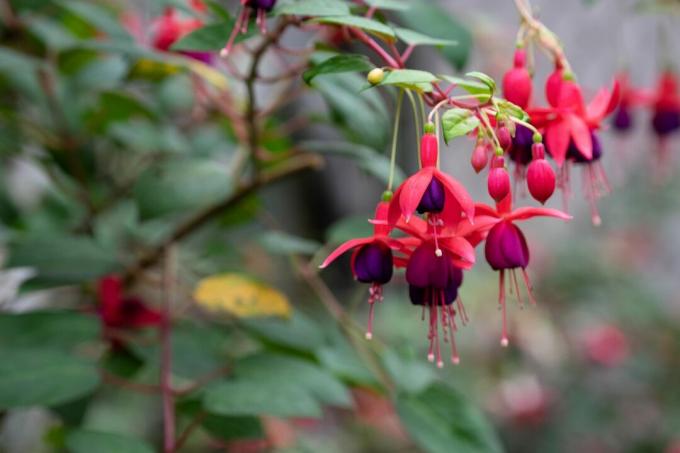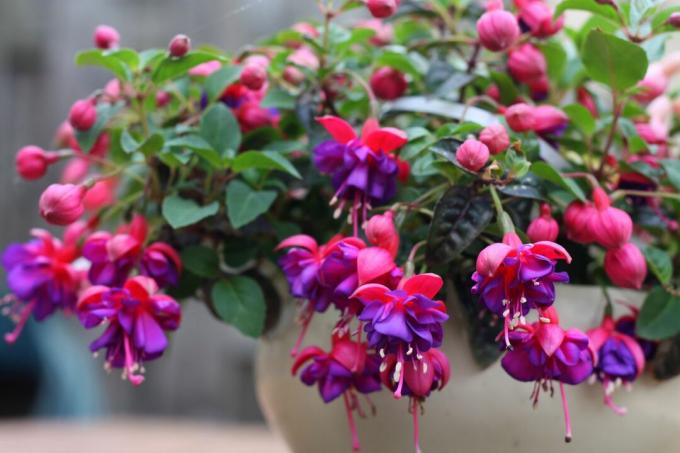Most fuchsias do not tolerate extreme cold. You can find out here how you can support your fuchsia in winter and overwinter it successfully.

The genus of fuchsias (fuchsia) includes over 100 different types in many different colors and shapes. The evening primrose (Onagraceae) originally comes from South and Central America, from where it spread in the 18th century was brought to Europe. In their natural environment, fuchsias are found in higher mountainous regions and on the fringes of rainforests. With us, the beautiful ornamental plant is often cultivated in pots, but also in the garden bed because of its flowers. However, many fuchsias do not tolerate extreme cold. Therefore, before the winter, various protective measures must be taken.
contents
- Fuchsias overwinter
- Prepare fuchsias for winter
- When does the fuchsia get too cold?
- Successfully overwintering fuchsias: this is important
- Overwinter fuchsias in the bed
- Overwinter fuchsias indoors in pots
- Hardy fuchsia varieties
Fuchsias overwinter
Many hobby gardeners only cultivate their fuchsias once a year and buy a new plant in the spring. However, the perennial fuchsias do not have to be thrown away in autumn, because most varieties can be overwintered with little effort. We will explain to you what to look out for when overwintering your fuchsia and then present a selection of hardy varieties.

Prepare fuchsias for winter
Before your (hardy) fuchsia can take a well-deserved rest, there are a few precautions to be taken be taken so that the plant survives the winter well and in the spring comes back to life awakens After flowering in autumn, the fuchsias hardly need any nutrients, which is why they should no longer be fertilized from September. In order to maintain a lush bloom, an annual pruning should also take place, because the annual shoots no longer produce flowers anyway.
If the fuchsias are placed in a bright place with over 10 °C (greenhouse, bright basement) over the winter, they will only get their shape in the following spring. If the hibernation takes place in a cool, dark place, however, the pruning should be done in autumn before the first frost. To do this, cut back around a third of the annual growth. One or two eyes per shoot should be left. If you overwinter in the dark, also remove the leaves (exception: small-leaved fuchsias) and the withered flowers. Dead and unwanted shoots are also completely removed.

Pruning makes wintering easier and, for example, reduces susceptibility to fungal diseases through improved lift circulation in the plant. Then nothing stands in the way of a move to the protected winter quarters. A detailed guide to Pruning the fuchsia you'll find here.
When does the fuchsia get too cold?
Basically, fuchsias prefer cool temperatures between 16 and 24 °C. However, most varieties do not tolerate temperatures below zero. Therefore, protective measures should be taken before the first frost. Also make sure not to put fuchsias outside in pot culture until April at the earliest. However, due to the risk of night frosts, be sure to choose a sheltered pitch. If you want to be on the safe side, fuchsias should not be put outside until mid-May anyway Due to the lack of winter hardiness, outdoor planting should only be done in mid-May after the ice saints be made.
Successfully overwintering fuchsias: this is important
If you have made the preparations mentioned and cut back the fuchsia, nothing stands in the way of overwintering. There is both the option of leaving the fuchsias outdoors and of relocating them to winter quarters as potted plants. We have summarized the most important information for you below.
Overwinter fuchsias in the bed
Many hardy fuchsia varieties with an upright growth habit are ideal for cultivation as garden shrubs in beds. Before the first frosts, you should cut back the shrub by a third and pile it up with soil. Then cover the plant with a layer of straw, brushwood or leaves. In addition, a garden fleece cover can help to insulate against the winter cold. In early spring you can cover the fuchsias again and remove dead shoots if necessary.

Overwinter fuchsias indoors in pots
Varieties that are not hardy are best cultivated in pots so that they can be moved to a frost-free spot in winter. A bright, cool room is particularly suitable for hibernation. A temperature between 8 and 10 °C is ideal for this. Only water your fuchsia during hibernation so that the root ball does not dry out. You can also do without fertilizers during this time. If there is only the possibility of a dark hibernation at a cool temperature (between 2 and 10 °C), a pruning and the removal of the leaves should take place in autumn. Regular ventilation also reduces the risk of fungal disease.
In spring (March) the fuchsia can slowly get used to warmth and light again. During this time it tolerates temperatures around 20 °C and the substrate should be kept moderately moist. If necessary, the plant should also be repotted so that it has enough space and sufficient nutrients. If no more frosts are to be expected, you can put the fuchsia outside again on the terrace or balcony from April.

Hardy fuchsia varieties
There are now many different fuchsia varieties that have been bred to tolerate cold and are therefore suitable for overwintering outdoors. Standing fuchsias, for example, are wonderfully suited as solitary plants for cultivation in planters. Hanging varieties come into their own in balcony boxes and hanging baskets.
Below we have a small selection of the most popular hardy ones for you fuchsia varieties compiled:
'Delicate Purple': simple flowers; dark pink sepals with purple-colored petals; semi-hanging growth (up to 40 cm); particularly suitable for planting in balcony boxes or hanging baskets
'dollar princess': medium-sized, double flowers; red sepals with violet petals; standing growth (up to 70 cm); can be grown very well as a bush or standard tree
'Cardinal Farges': single to double flowers; red sepals with white petals; standing growth (up to 60 cm); prefers partially shaded locations
'Tom West': small, simple flowers; variegated; red sepals and purple-red petals; hanging growth (up to 30 cm)
,Ballerina': medium-sized flowers; red sepals with white petals; standing growth (up to 45 cm)
'Alice Hoffman': red-white flowers; standing growth; reaches a height of 30 to 60 cm
'Caledonia': bright red flowers; grows upright and reaches heights of up to 60 cm

Also some hardy wild species - like the Magellanic fuchsia (Fuchsia magellanica) or the robust Fuchsia regia ssp. reitzii – are suitable for planting outdoors. An extensive collection hardy fuchsia varieties you'll find here.
In order for your fuchsias to thrive and produce lots of flowers, you should also consider other aspects in addition to the measures listed for correct overwintering. You will find further information on the correct one here Caring for your fuchsias.



